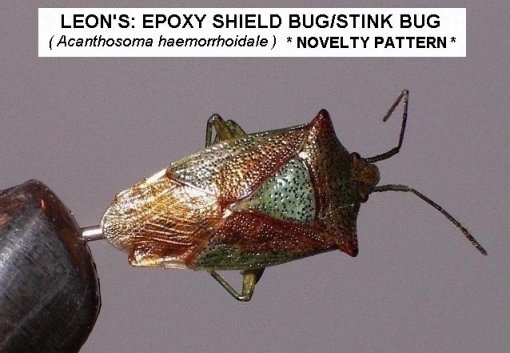| Tools and Materials | Clear Epoxy Glue two part mix 10 minute set time, Photograph of insect or use of Bench Magnifier on real insect or Microscope to aid detail work. Cocktail Sticks and Cocktail Sticks with small cloth material stuck on tips (see Technique below) Hot Soldering iron and or Hair Drier, Permanent Coloured Ink Pens used for Overhead Projector film. Cotton Cloth, Monofilament Nylon, Super Glue. Clear Varnish,
Vaseline (Petroleum Jelly) Cotton Buds. 8/0 Black Tying Thread.
|
| Build Technique: | Although classed as one of my * Novelty Patterns * it may seem difficult to make, but once you master the technique you can re-create all types of insects from epoxy glue. This one in particular has a wide body shape. So you need to use a base on the hook in which to build on the pattern. I have firstly wrapped the hook shank with tying thread and then stuck on 2 small pieces of Cotton Fabric one on the underside of the hook shank and then one on top of that, then the cotton is saturated with Super Glue and when dry the cotton is trimmed at the sides to form shape like a tear drop, this is very strong on the hook shank and dose not rotate afterwards, I have used plastic
etc. but this dose not adhere to the shank very well and find always to use cotton material the best to form the base for large
Body insects.
Know Your Epoxy' It is important to get to know your epoxy set times, mix small amount of equal proportions on a small piece of paper epoxy and hardener mixed with cocktail stick. Time it! And when the epoxy starts to harden then use a cocktail stick that you have stuck on a small piece of cotton material on the tip of the cocktail stick and use Vaseline on the cotton
This is used to create markings of the insect when the Epoxy Glue is near set but still soft enough to produce final marks on the epoxy glue. As with the indentations on the Carapace a Cocktail Stick with the tip covered with Vaseline is used to stop the cocktail stick from sticking to the glue. The legs are made up from used Monofilament Nylon and to create the Thicker portion of the Antenna I have simply used Black Tying thread on the Monofilament Nylon and covered it with Super Glue, Rear Underside legs are also Monofilament Nylon but built thicker again using Epoxy Glue, The underside of the insect is built with Epoxy Glue and the coloration of this particular insect is Yellowish/ Beige but depends on what species you are going to make.
To Create the Darker Markings in the Indentations you have made on the Carapace with the cocktail stick I have just used the Black Permanent Ink Pens and covered the area's with the pen and then used a Cotton Bud to wipe of the excess to leave the hole markings filled with the black ink. Once complete and dry the whole carapace is cleaned with Isopropanol Alcohol
To remove any trace of Vaseline and then the whole carapace is thinly covered with Varnish.
The use of using the Soldering Iron and or Hair Dryer is to re-soften the Epoxy Glue should you require re-working an area on the pattern. You do not touch it with the Soldering Iron but use the heat radiated from it close to were you require re-work.
Perhaps time consuming and more of a sculpture art it is no different than those who produce wonderful creations of Salmon Flies using fur and feather and it is a matter of practice and practically any insect can be made using this technique. |

